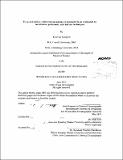| dc.contributor.advisor | Mak Saito. | en_US |
| dc.contributor.author | Goepfert, Tyler Jay | en_US |
| dc.contributor.other | Woods Hole Oceanographic Institution. | en_US |
| dc.date.accessioned | 2013-11-18T19:06:12Z | |
| dc.date.available | 2013-11-18T19:06:12Z | |
| dc.date.copyright | 2013 | en_US |
| dc.date.issued | 2013 | en_US |
| dc.identifier.uri | http://hdl.handle.net/1721.1/82303 | |
| dc.description | Thesis (S.M.)--Joint Program in Chemical Oceanography (Massachusetts Institute of Technology, Department of Earth, Atmospheric, and Planetary Sciences; and the Woods Hole Oceanographic Institution), 2013. | en_US |
| dc.description | Cataloged from PDF version of thesis. | en_US |
| dc.description | Includes bibliographical references. | en_US |
| dc.description.abstract | Nitrogen and trace metal biogeochemical effects on phytoplankton productivity were compared through whole water bottle incubations and proteomic evaluation of in situ harvested particulate matter from two distinct oceanographic regions: the Equatorial Pacific Upwelling and the South Pacific Gyre. Phytoplankton growth in both regions was stimulated by nitrogen additions with equivalent response from nitrate and urea. In the gyre, trace metal additions did not yield a chlorophyll response, however nickel treatments showed evidence of nickel-limited nitrogen fixation. In contrast, cell growth at the upwelling site was primarily iron-limited and iron plus urea or nitrate additions further enhanced the chlorophyll response, indicative of secondary nitrogen limitation. Nitrogen stress proteins and urea transporters from cyanobacteria in these field sites showed similar trends, with both increasing in waters containing lower dissolved inorganic nitrogen. Together with bottle incubations, the abundant urea transporters and nitrogen stress proteins indicate the importance of urea in these field sites. Representative cyanobacteria cultures (Synechococcus strain WH8020, and Prochlorococcus strain MED4) were evaluated to constrain urea uptake rates and explore the potential for compound specific uptake rates. Together, results from this study indicate that urea may represent an under-recognized component of the marine microbial nitrogen cycle. | en_US |
| dc.description.statementofresponsibility | by Tyler Jay Goepfert. | en_US |
| dc.format.extent | 99 p. | en_US |
| dc.language.iso | eng | en_US |
| dc.publisher | Massachusetts Institute of Technology | en_US |
| dc.rights | M.I.T. theses are protected by
copyright. They may be viewed from this source for any purpose, but
reproduction or distribution in any format is prohibited without written
permission. See provided URL for inquiries about permission. | en_US |
| dc.rights.uri | http://dspace.mit.edu/handle/1721.1/7582 | en_US |
| dc.subject | Joint Program in Chemical Oceanography. | en_US |
| dc.subject | Earth, Atmospheric, and Planetary Sciences. | en_US |
| dc.subject | Woods Hole Oceanographic Institution. | en_US |
| dc.subject.lcsh | Primary productivity (Biology) | en_US |
| dc.subject.lcsh | Nitrogen cycle | en_US |
| dc.title | Urea and nickel utilization in marine cyanobacteria as evaluated by incubation, proteomic, and uptake techniques | en_US |
| dc.type | Thesis | en_US |
| dc.description.degree | S.M. | en_US |
| dc.contributor.department | Joint Program in Chemical Oceanography | en_US |
| dc.contributor.department | Woods Hole Oceanographic Institution | en_US |
| dc.contributor.department | Massachusetts Institute of Technology. Department of Earth, Atmospheric, and Planetary Sciences | |
| dc.identifier.oclc | 861500017 | en_US |
